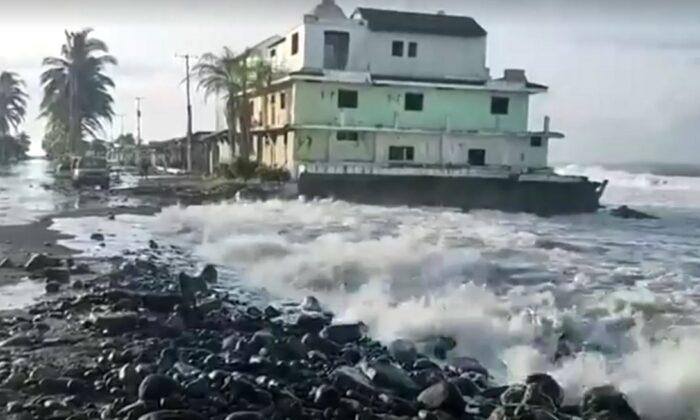Fever, cough and shortness of breath are found in the vast majority of all COVID-19 cases. But there are additional signals of the virus, some that are very much like cold or flu, and some that are more unusual.
Any or all symptoms can appear anywhere from two to 14 days after exposure to the virus, according to the U.S. Centers for Disease Control and Prevention.
1. Shortness of Breath
Shortness of breath is not usually an early symptom of COVID-19, but it is the most serious. It can occur on its own, without a cough. If your chest becomes tight or you begin to feel as if you cannot breathe deeply enough to fill your lungs with air, that’s a sign to act quickly, experts say.“If there’s any shortness of breath immediately call your health care provider, a local urgent care or the emergency department,” said American Medical Association president Dr. Patrice Harris.
“If the shortness of breath is severe enough, you should call 911,” Harris added.
The CDC lists other emergency warning signs for COVID-19 as a “persistent pain or pressure in the chest,” and “bluish lips or face,” which can indicate a lack of oxygen.
2. Fever
Fever is a key sign of COVID-19. Because some people can have a core body temperature lower or higher than the typical 98.6 degrees Fahrenheit (37 degrees Celsius), experts say not to fixate on a number.CNN anchor Chris Cuomo, who is battling the virus from his home in New York, is one of those people.
“I run a little cool. My normal temperature is 97.6, not 98.6. So, even when I’m at 99 that would not be a big deal for most people. But, for me, I’m already warm,” Cuomo told CNN Chief Medical Correspondent Dr. Sanjay Gupta in a CNN Town Hall.

Most children and adults, however, will not be considered feverish until their temperature reaches 100 degrees Fahrenheit (37.7 degrees Celsius).
“There are many misconceptions about fever,” said Dr. John Williams, chief of the division of pediatric infectious diseases at the University of Pittsburgh Medical Center Children’s Hospital of Pittsburgh.
“We all actually go up and down quite a bit during the day as much as half of a degree or a degree,” Williams said, adding that for most people “99.0 degrees or 99.5 degrees Fahrenheit is not a fever.”
Don’t rely on a temperature taken in the morning, said infectious disease expert Dr. William Schaffner, a professor of preventative medicine and infectious disease at Vanderbilt University School of Medicine in Nashville. Instead, take your temperature in the late afternoon and early evening.
“Our temperature is not the same during the day. If you take it at eight o'clock in the morning, it may be normal,” Schaffner explained.
3. Dry Cough
Coughing is another common symptom, but it’s not just any cough.“It’s not a tickle in your throat. You’re not just clearing your throat. It’s not just irritated,” Schaffner explained.
The cough is bothersome, a dry cough that you feel deep in your chest.
“It’s coming from your breastbone or sternum, and you can tell that your bronchial tubes are inflamed or irritated,” Schaffner added.
4. Chills and Body Aches
“The beast comes out at night,” said Cuomo, referencing the chills, body aches and high fever that visited him on April 1.‘It was like somebody was beating me like a pinata. And I was shivering so much that ... I chipped my tooth. They call them the rigors,” he said from his basement, where he is quarantined from the rest of his family.
“I was hallucinating. My dad was talking to me. I was seeing people from college, people I haven’t seen in forever, it was freaky,” Cuomo said.
Not everyone will have such a severe reaction, experts say. Some may have no chills or body aches at all. Others may experience milder flu-like chills, fatigue and achy joints and muscles, which can make it difficult to know if it’s flu or the CCP virus that’s to blame.
5. Sudden Confusion
Speaking of worsening signs, the CDC says a sudden confusion or an inability to wake up and be alert may be a serious sign that emergency care may be needed. If you or a loved one has those symptoms, especially with other critical signs like bluish lips, trouble breathing or chest pain, the CDC says to seek help immediately.6. Digestive Issues
At first science didn’t think diarrhea or other typical gastric issues that often come with the flu applied to the CCP virus, also known as SARS-CoV-2. As more research on survivors becomes available, that opinion has changed.“In a study out of China where they looked at some of the earliest patients, some 200 patients, they found that digestive or stomach GI (gastrointestinal) symptoms were actually there in about half the patients,” Gupta said on CNN’s New Day news program.
Overall, “I think we’re getting a little bit more insight into the types of symptoms that patients might have,” Gupta said.
7. Pink Eye
Research from China, South Korea and other parts of the world indicate that about 1 percent to 3 percent of people with COVID-19 also had conjunctivitis, commonly known as pink eye.Conjunctivitis, a highly contagious condition when caused by a virus, is an inflammation of the thin, transparent layer of tissue, called conjunctiva, that covers the white part of the eye and the inside of the eyelid.
But SARS-CoV-2 is just one of many viruses that can cause conjunctivitis, so it came as no real surprise to scientists that this newly discovered virus would do the same.
8. Loss of Smell and Taste
In mild to moderate cases of CCP virus, a loss of smell and taste is emerging as one of the most unusual early signs of COVID-19.“What’s called anosmia, which basically means loss of smell, seems to be a symptom that a number of patients developed,” CNN Chief Medical Correspondent Dr. Sanjay Gupta told CNN anchor Alisyn Camerota on New Day.
“It may be linked to loss of taste, linked to loss of appetite, we’re not sure—but it’s clearly something to look out for,” Gupta said. “Sometimes these early symptoms aren’t the classic ones.”
“Anosmia, in particular, has been seen in patients ultimately testing positive for the coronavirus with no other symptoms,” according to the American Academy of Otolaryngology-Head and Neck Surgery.
A recent analysis of milder cases in South Korea found the major presenting symptom in 30 percent of patients was a loss of smell. In Germany, more than two in three confirmed cases had anosmia.
It has long been known in medical literature that a sudden loss of smell may be associated with respiratory infections caused by other types of coronaviruses, so it wasn’t a surprise that the CCP virus would have this effect, according to ENT UK (PDF), a professional organization representing ear, nose and throat surgeons in the United Kingdom.
9. Fatigue
For some people, extreme fatigue can be an early sign of the virus. The WHO report found nearly 40 percent of the nearly 6,000 people with laboratory confirmed cases experienced fatigue.Just a few days into his quarantine, Cuomo was already exhausted by the fevers and body aches the disease brings.
“I’m so lethargic that I can stare outside, and, like, an hour-and-a-half goes by,” Cuomo told Gupta on Anderson Cooper 360. “I think I took a 10-minute nap, and it was three and a half hours.”
10. Headache, Sore Throat, Congestion
The WHO report also found nearly 14 percent of the almost 6,000 cases of COVID-19 in China had symptoms of headache and sore throat, while almost 5 percent had nasal congestion.Certainly not the most common signs of the disease, but obviously similar to colds and flu. In fact, many symptoms of COVID-19 can resemble the flu, including headaches and the previously mentioned digestive issues, body aches and fatigue. Still other symptoms can resemble a cold or allergies, such as a sore throat and congestion.
So What Should You Do?
“At this moment, the current guidance—and this may change—is that if you have symptoms that are similar to the cold and the flu and these are mild symptoms to moderate symptoms, stay at home and try to manage them” with rest, hydration and the use of fever-reducing medications, said the AMA’s Harris.That advice does not apply if you are over age 60, since immune systems weaken as we age or if you are pregnant. Anyone with concerns about the virus should call their healthcare provider, according to the CDC.
It’s unclear whether pregnant women have a greater chance of getting severely ill from the CCP virus, but the CDC has said that women experience changes in their bodies during pregnancy that may increase their risk of some infections.
In general, COVID-19 infections are riskier if you have underlying health conditions such as diabetes, chronic lung disease or asthma, heart failure or heart disease, sickle cell anemia, cancer (or are undergoing chemotherapy), kidney disease with dialysis, a body mass index (BMI) over 40 (extremely obese) or an autoimmune disorder.
“Older patients and individuals who have underlying medical conditions or are immunocompromised should contact their physician early in the course of even mild illness,” the CDC advises.
To be clear, you are at higher risk—even if you are young—if you have underlying health issues.
“People under 60 with underlying illnesses, with diabetes, heart disease, immunocompromised or have any kind of lung disease previously, those people are more vulnerable despite their younger age,” Schaffner said.
How to Be Evaluated
If you have no symptoms, please don’t ask for testing or add to backlog of calls at testing centers, clinics, hospitals and the like, experts say.“We do not test people with no symptoms because it’s a resource issue,” Schaffner said about the assessment center at Vanderbilt. “However, we are emphasizing that people who have this small cluster of important symptoms—fever and anything related to the lower respiratory tract such as cough and difficulty breathing—reach out to be evaluated.”
If you do have those three signs, where should you go?
“If you have insurance and you’re looking for a provider or someone to call or connect with, there’s always a number on the back of your insurance card; or if you go online, there is information for patients,” Harris said.
“If you don’t have insurance, you can start with the state health department or the local community health centers, those are officially known as federally qualified health centers,” Harris advised, adding that some states have a 1-800 hotline number to call.
“If there is a testing and assessment center near you, you can go there directly,” Schaffer said. “It’s always good to notify them that you’re coming. Otherwise, you need to call your healthcare provider and they will direct you what to do.”




